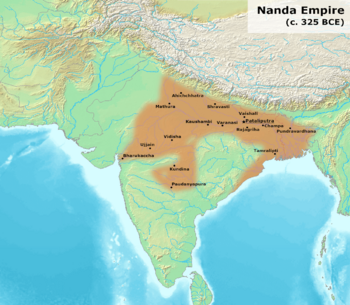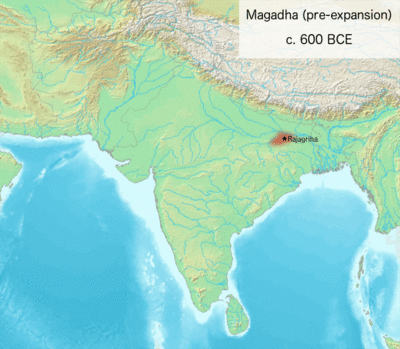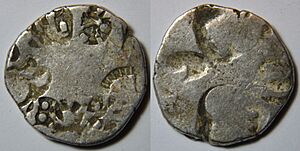Nanda Empire facts for kids
Quick facts for kids
Nanda Empire
|
|||||||||||
|---|---|---|---|---|---|---|---|---|---|---|---|
| c. 345 BCE–c. 322 BCE | |||||||||||

Possible extent of the Nanda Empire under its last ruler Dhana Nanda (c. 325 BCE).
|
|||||||||||
| Status | Empire | ||||||||||
| Capital | Pataliputra | ||||||||||
| Religion | Hinduism Buddhism Jainism |
||||||||||
| Government | Monarchy | ||||||||||
| Emperor | |||||||||||
|
• c. 345 – c. 340 BCE
|
Mahapadma (first) | ||||||||||
|
• c. 329 – c. 322 BCE
|
Dhana (last) | ||||||||||
| Historical era | Iron Age India | ||||||||||
|
• Established
|
c. 345 BCE | ||||||||||
|
• Disestablished
|
c. 322 BCE | ||||||||||
|
|||||||||||
| Today part of | Bangladesh India Nepal |
||||||||||
The Nanda dynasty was an important ruling family in ancient India. They ruled the powerful Magadha kingdom in northern India around 345 to 322 BCE. The Nandas took over from the Shaishunaga dynasty and made their empire much bigger, covering a large part of northern India.
Historians aren't completely sure about the exact dates or names of all Nanda kings. However, based on old Buddhist writings, they likely ruled for about 22 years. The Nanda kings were known for setting up a very strong and organized government. They also gathered a lot of wealth, possibly by creating new money and tax systems.
Some old stories say that the Nanda kings were not very popular. This was because they came from humble beginnings, collected too many taxes, and sometimes behaved badly. The last Nanda king was eventually defeated by Chandragupta Maurya. Chandragupta then started the famous Maurya Empire.
When Alexander the Great invaded Punjab (a region in India and Pakistan) around 327–325 BCE, he heard about the Nanda kingdom. Greek and Roman writers described it as a very strong military power. Alexander's soldiers were tired from fighting for many years. The thought of facing the powerful Nanda army made them refuse to go further. This forced Alexander to end his campaign in India.
Contents
Who Were the Nanda Kings?
Old stories from India and Greece say that the first Nanda king came from a simple background. The Greek historian Diodorus wrote that the Nanda king was believed to be the son of a barber. Another Roman historian, Curtius, added that this barber became close to the queen. He then secretly killed the king and took control of the kingdom.
Jain texts also agree that the first Nanda king was the son of a barber. However, these texts also suggest that the Nanda kings later claimed to be from the Kshatriya class. This was a high social class of warriors and rulers.
The Puranas, which are ancient Indian religious texts, name the first Nanda king as Mahapadma. They say he was the son of a Shaishunaga king. But even these texts hint that the Nandas were of lower birth. They mention that Mahapadma's mother belonged to the Shudra class, which was the lowest of the four main social classes (varnas).
Because both Greek and Jain stories mention the barber origin, it seems more likely to be true than the Puranic story.
How Long Did the Nandas Rule?
Historians disagree on how long the Nanda dynasty ruled. Some ancient texts say they ruled for 88 years, while others say 40 years or even 29 years.
Many historians believe the Nanda rule lasted from about 344 BCE to 322 BCE. This idea comes from Sri Lankan Buddhist traditions, which say the Nandas ruled for 22 years. Other theories suggest their rule might have started earlier, around 424 BCE.
Jain writers from the 14th century say the Nanda rule, with nine kings, lasted for 155 years. They claim the Nandas came to power after King Palaka and then captured the city of Ujjayini. While not all these dates are certain, they give us an idea of how long people thought the Nandas ruled.
The Nanda Kings' Names
Buddhist, Jain, and Puranic traditions all agree there were nine Nanda kings. However, they don't agree on their names.
Greek and Roman accounts suggest there were two generations of Nanda rulers. They mention one Nanda king, Agrammes or Xandrames, who was ruling when Alexander the Great was in India. "Agrammes" might be a Greek version of "Augrasainya," meaning "son of Ugrasena." Ugrasena is the name of the Nanda founder in Buddhist stories.
The Puranas say the founder was Mahapadma. They claim he ruled for a very long time (88 years in some texts, 28 in others). His eight sons then ruled for a total of 12 years. Only one son, Sukalpa, is named.
The Sri Lankan Buddhist text Mahavamsa lists nine Nanda kings, who were brothers ruling one after another for a total of 22 years. These kings were:
Where Was the Nanda Empire?

The Nanda capital city was Pataliputra, which is near modern-day Patna in eastern India. This is confirmed by Buddhist, Jain, and Greek writings. The Greek accounts say that Agrammes (the Nanda king) ruled the Ganges valley and the eastern regions.
The Nanda Empire stretched from present-day Punjab in the west to Odisha in the east. They controlled eastern India, the Ganges valley, and at least part of Kalinga. It's also likely they controlled the Avanti region in Central India. This helped their successor, Chandragupta Maurya, conquer western India later.
The Puranas say that the Nanda king Mahapadma defeated many Kshatriya warrior groups. This means he gained complete control over a large area. These groups included people from Mithila, Kashi, Kosala, Panchala, Shurasena, Kuru, Haihaya, Vitihotra, Kalinga, and Ashmaka. This shows how far their power reached.
For example, the Nanda control over Kalinga (modern-day Odisha) is supported by the Hathigumpha inscription. This inscription, from a later king, mentions that "Nanda-raja" (the Nanda king) had dug a canal in Kalinga. He also took a Jain idol from there.
Nanda Military Power
Alexander the Great invaded northwestern India when the last Nanda king, Dhana Nanda, was ruling. In 326 BCE, Alexander's army reached the Beas River. Beyond this river lay the Nanda territory.
According to ancient writers, the Nanda army was huge. Curtius reported that the Nanda king had 200,000 foot soldiers, 20,000 horsemen, 3,000 war elephants, and 2,000 chariots. Other sources give even higher numbers for elephants and chariots. These numbers might have been exaggerated to scare Alexander's army.
The Nanda army never actually fought Alexander. His soldiers refused to go any further east. They were tired and homesick after years of fighting. The idea of facing the massive Nanda army made them mutiny. This forced Alexander to turn back from India.
How the Nanda Empire Was Run
We don't have much information about how the Nanda government worked. The Puranas describe the Nanda king as a "single ruler." This suggests the Nanda Empire was a strong, unified kingdom, not just a collection of independent states.
However, Greek accounts suggest a more flexible system. They mention that some areas were ruled by local aristocrats. This means the Nandas might have had tight control over their main areas like Bihar and Uttar Pradesh. But they might have allowed some freedom in the outer parts of their empire.
The Nanda kings greatly strengthened the Magadha kingdom. They built on the work of earlier dynasties to create the first large empire in northern India. Magadha's capital, Pataliputra, was well-protected by its location near the Ganges River and Son rivers. The Ganges also connected the kingdom to important trade routes. The region had fertile land and access to wood and elephants.
Ministers and Scholars
Jain traditions say that Kalpaka was the first Nanda king's minister. He encouraged the king to expand the empire. It seems that ministerial jobs in the Nanda Empire were passed down through families.
Old stories also claim that during the Nanda rule, Pataliputra became a center for both wealth and learning. Famous grammarians (experts in language rules) like Panini and Katyayana are said to have lived during this time.
Nanda Wealth

Many historical sources talk about the great wealth of the Nandas. The Mahavamsa says the last Nanda king was a huge treasure-hoarder. He collected enormous riches, possibly burying them in the Ganges River. He also got more wealth by taxing many different things, like animal skins, tree sap, and stones.
A Tamil poet named Mamulanar also mentioned the "untold wealth of the Nandas." The Chinese traveler Xuanzang in the 7th century spoke of "five treasures of king Nanda's seven precious substances."
The Nandas might have introduced a new system of measuring and a new currency. This could explain how they became so wealthy. A collection of coins found at the ancient site of Pataliputra likely belongs to the Nanda period.
Religion in the Nanda Empire
People in the Nanda Empire followed different religions, including Hinduism, Buddhism, and Jainism. The Nanda and later Maurya rulers seemed to support religions that started in the Magadha region, like Jainism and Ajivikism. However, there is no evidence that the Nanda rulers forced anyone to convert or treated different religions unfairly.
Before the Nandas, the Vedic Brahmanism was supported by many smaller kings. When the Nanda and Maurya empires became more powerful and centralized, these smaller kings lost influence. This led to a gradual decline in the traditional Vedic society.
Jain stories suggest that some Nanda ministers were interested in Jainism. For example, when a minister named Shakatala died, his son Sthulabhadra chose to become a Jain monk instead of taking his father's job.
Nanda Architecture
A stone piece of an arch was found at Kumhrar, Pataliputra. This piece is believed to be from the Nanda period, before the Mauryas. It has old Brahmi letters carved on it and might have been part of a decorative gateway.
Why the Nandas Were Overthrown
All historical accounts agree that the last Nanda king was not liked by his people. Diodorus wrote that the Nanda king was seen as "worthless" and not respected because of his low birth. Plutarch also said that the Nanda king was hated and despised by his subjects because he was wicked. Buddhist traditions blame the Nandas for being greedy and for making people pay too many taxes. The Puranas call the Nandas "adharmika", meaning they didn't follow righteous conduct.
The Nanda dynasty was eventually defeated by Chandragupta Maurya. He was helped by his wise teacher and later minister, Chanakya. Some stories even suggest that Chandragupta was related to the Nanda family.
The Buddhist text Milinda Panha describes a huge battle between the Nanda general Bhaddasala and Chandragupta. It claims that millions of soldiers and thousands of elephants and horses were killed. While these numbers are probably exaggerated, they show that the overthrow of the Nanda dynasty was a very violent event.

